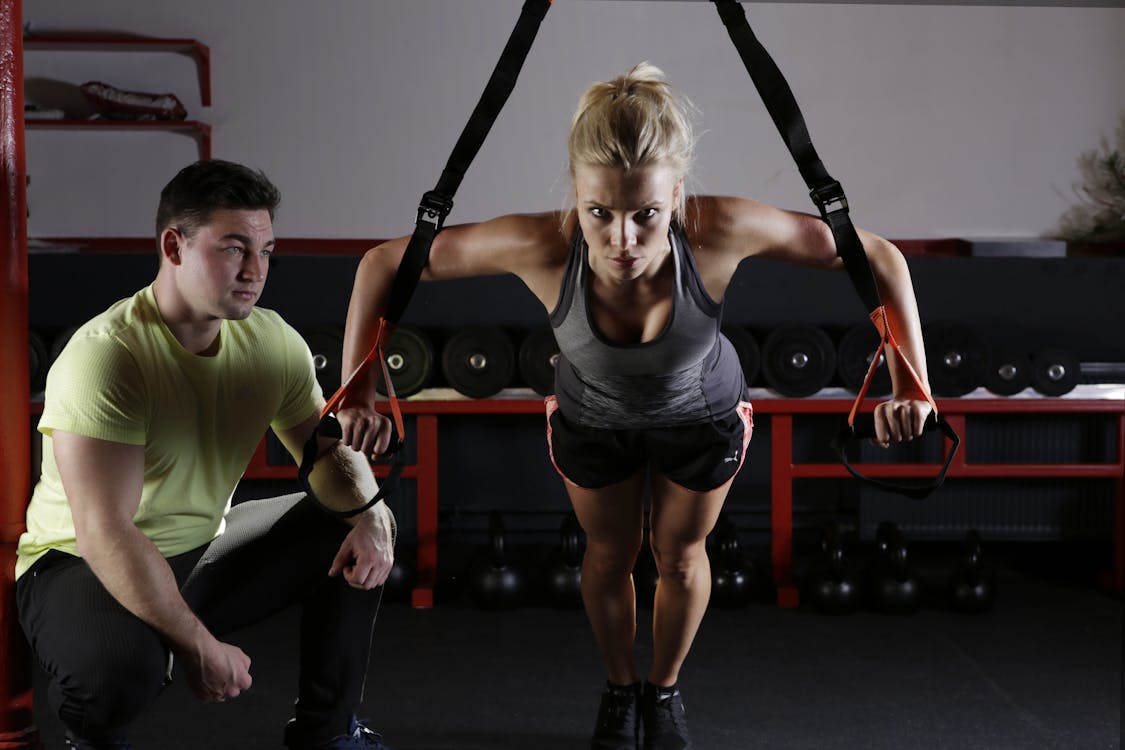
For many fitness enthusiasts and athletes, gaining mass is a significant objective, whether it’s for improved athletic performance, aesthetics, or overall health. However, the process of gaining mass and building muscle can be overwhelming and confusing, especially with the abundance of information available.
Throughout this article, we aim to demystify the world of muscle growth and provide you with a well-structured roadmap to reach your full potential. Whether you’re a beginner seeking guidance on how to start your fitness journey or an experienced lifter looking to break through plateaus, this guide is tailored to cater to all levels of experience and expertise.
Also, we will delve into various aspects of muscle gain, including nutrition, workout routines, recovery, and mental fortitude. You will learn how to optimize your diet, fine-tune your training, and adopt a mindset that fosters discipline and perseverance.
Remember, building muscle and strength is not just about lifting weights; it’s a holistic approach that involves the integration of nutrition, exercise, and mental resilience. By understanding the science behind muscle growth and applying the proven strategies outlined in this article, you will be well-equipped to take charge of your body and achieve the gains you desire.
So, let’s embark on this transformative journey together, where hard work, dedication, and knowledge converge to unlock the immense potential within you. Get ready to challenge yourself, push your limits, and discover the incredible power of your body to adapt, grow, and achieve greatness.
- The Science of Muscle Growth:
- Setting Up Your Nutrition Plan For Gaining Mass:
- The Role of Macronutrient-Based Meal Plans:
- Effective Workout Strategies For Gaining Mass:
- Strength Training vs. Hypertrophy Training:
- Essential Compound Exercises For Gaining Mass:
- Targeting Specific Muscle Groups:
- The Role of Supplements in Gaining Mass:
- The Significance of Recovery and Rest:
- Overcoming Plateaus and Challenges:
- Conclusion:
The Science of Muscle Growth:
The science of muscle growth, also known as muscle hypertrophy, is a complex process that involves various physiological mechanisms and pathways. In general, muscle growth occurs as a result of progressive overload, which means subjecting the muscle to gradually increasing levels of stress or resistance over time.
The primary cellular mechanism responsible for muscle growth is called muscle protein synthesis (MPS), which is the process by which the body synthesizes new muscle proteins. MPS is stimulated by a variety of factors, including mechanical tension (i.e. the force generated by muscle contractions), metabolic stress (i.e. the buildup of metabolic byproducts during exercise), and hormonal signaling (i.e. the release of hormones such as testosterone and growth hormone).
Resistance training is the most effective way to stimulate muscle growth, as it creates the necessary mechanical tension and metabolic stress to trigger MPS. When you lift weights, you create micro-tears in your muscle fibers, which then triggers a cascade of cellular processes that ultimately lead to muscle growth.
In addition to resistance training, proper nutrition and recovery are also essential for muscle growth. Adequate protein intake is necessary to provide the building blocks for new muscle protein synthesis, while sufficient rest and recovery allow the body to repair and rebuild damaged muscle tissue.
Overall, the science of muscle growth is a complex and multifactorial process that requires a combination of proper training, nutrition, and recovery to achieve optimal results.
Muscle Fibers: The Building Blocks of Strength:
Muscles are composed of individual fibers that contract to generate force and movement. There are primarily two types of muscle fibers: Type I (slow-twitch) and Type II (fast-twitch) fibers. Each type has distinct characteristics and functions.
Type I fibers are more fatigue-resistant and are involved in activities that require endurance, such as long-distance running. On the other hand, Type II fibers produce more force but fatigue more quickly, making them ideal for short bursts of intense activity like weightlifting or sprinting.
The proportion of Type I and Type II fibers in your muscles is largely determined by genetics. However, through specific training methods, you can influence their development to some extent.

The Role of Progressive Overload:
To stimulate muscle growth, you need to challenge your muscles progressively. Progressive overload is the principle of gradually increasing the stress placed on your muscles during training. By consistently pushing your muscles beyond their comfort zone, you force them to adapt and grow stronger.
This can be achieved by increasing the weight you lift, performing more repetitions, or altering the intensity and frequency of your workouts. A well-structured progressive overload plan is crucial for sustained muscle growth and avoiding plateaus.
The Hypertrophy Process:
Hypertrophy is the process of muscle growth in response to the demands placed upon them. When you lift weights, tiny microtears occur in your muscle fibers. During the recovery process, these fibers repair and adapt to handle the increased load. As a result, the muscle becomes larger and stronger.
Hypertrophy can occur through two primary mechanisms: myofibrillar hypertrophy, which involves an increase in the size and number of myofibrils (contractile fibers within muscle cells), and sarcoplasmic hypertrophy, which involves an increase in the fluid and energy stores surrounding the myofibrils.
Understanding these processes will help you tailor your training to achieve specific goals, whether it’s increasing strength, muscle size, or a combination of both.
Setting Up Your Nutrition Plan For Gaining Mass:
If you’re looking to build muscle, it’s important to have a nutrition plan that supports your goals. Now, we will focus on the essential aspect of setting up a nutrition plan that complements your muscle-building goals. Proper nutrition is the backbone of any successful mass-gaining journey, as it provides the necessary building blocks for muscle repair, growth, and overall recovery.
What is Caloric Surplus:
One of the fundamental principles of gaining mass is consuming more calories than your body expends. This caloric surplus provides the energy needed for muscle growth and ensures that your body has enough nutrients to support the recovery process.
To determine the appropriate caloric surplus, you need to calculate your Total Daily Energy Expenditure (TDEE) – the number of calories your body burns in a day, taking into account your basal metabolic rate (BMR) and physical activity level. Once you have your TDEE, you can add a surplus of calories on top of it to facilitate muscle gain.
The Role of Proteins in Gaining Mass:
Protein is the most critical macronutrient for muscle growth. It is composed of amino acids, which act as the building blocks for muscle repair and synthesis. Consuming an adequate amount of protein is essential to support muscle recovery and promote a positive nitrogen balance.
Include a variety of high-quality protein sources in your diet, such as lean meats, poultry, fish, eggs, dairy products, legumes, and plant-based options like tofu and tempeh. Aim for around 1.2 to 2.2 grams of protein per kilogram of body weight per day, depending on your activity level and training intensity.
Carbohydrates for Energy;
Carbohydrates are the primary source of energy for your body, especially during intense workouts. They replenish glycogen stores in your muscles and provide the fuel needed for effective training sessions.
Focus on consuming complex carbohydrates like whole grains, fruits, vegetables, and legumes. These slow-digesting carbs provide a steady release of energy and help maintain stable blood sugar levels, preventing energy crashes.
Healthy Fats for Hormonal Balance:
Dietary fats are crucial for hormone production and overall health. Healthy fats, such as those found in avocados, nuts, seeds, olive oil, and fatty fish, support testosterone production, which plays a vital role in muscle building.
While fats are calorie-dense, they are still an essential part of your nutrition plan. Aim to include them in moderation to support optimal hormonal function.
Micronutrients and Hydration:
In addition to macronutrients, don’t overlook the importance of micronutrients. These vitamins and minerals are essential for various bodily functions, including enzyme activity and immune support. Eating a diverse range of nutrient-dense foods will help ensure you’re getting the necessary micronutrients.
Furthermore, hydration is critical for overall performance and recovery. Aim to drink plenty of water throughout the day to maintain proper hydration levels.
Meal Timing and Frequency:
While the total daily caloric intake is crucial, meal timing and frequency can also impact your muscle-building progress. Aim to eat protein-rich meals every 3-4 hours to provide a steady stream of amino acids for muscle repair. Additionally, consuming a mix of protein and carbohydrates after your workouts can enhance recovery and muscle protein synthesis.

The Role of Macronutrient-Based Meal Plans:
Macronutrients, which include carbohydrates, proteins, and fats, are essential for building muscle and gaining mass. Therefore, macronutrient-based meal plans can play an important role in helping individuals gain mass.
A macronutrient-based meal plan is a nutrition plan that focuses on consuming specific amounts of carbohydrates, proteins, and fats to support muscle growth and weight gain. The specific macronutrient ratios may vary depending on individual goals, body composition, and activity level.
Now, we will delve into the different types of macronutrient-based meal plans and how to choose the one that best aligns with your muscle-building goals and lifestyle. Each macronutrient – protein, carbohydrates, and fats – plays a unique role in your nutrition plan, and understanding how to balance them effectively will optimize your gains.
1. The Balanced Approach:
The balanced approach to meal planning involves consuming a relatively equal proportion of each macronutrient – protein, carbohydrates, and fats – in each meal. This approach is suitable for individuals seeking overall health and well-rounded nutrition.
The balanced approach ensures that your body receives a steady supply of energy from carbohydrates, essential building blocks from protein, and hormone support from healthy fats. This meal plan is relatively straightforward to follow and works well for those who engage in a variety of physical activities, including weightlifting and cardio.
2. The High-Protein, Moderate-Carbohydrate Plan:
This meal plan emphasizes higher protein intake while moderating carbohydrate consumption. It is particularly beneficial for individuals aiming to maximize muscle growth and recovery while managing body fat levels.
High-protein intake supports muscle protein synthesis and promotes a positive nitrogen balance, creating an ideal environment for muscle repair and growth. Carbohydrates are strategically consumed to provide energy for workouts and replenish glycogen stores without excessive caloric surplus.
3. The Macronutrient Cycling Approach:
Macronutrient cycling involves varying the proportions of protein, carbohydrates, and fats on different days or during specific phases of your training program. This approach can be beneficial for breaking through plateaus and enhancing muscle growth.
For instance, you might have higher carbohydrate days on intense training days to support energy levels and recovery, and lower carbohydrate days on rest days or during phases of lower training volume to facilitate fat burning.
4. The Flexible Dieting Approach:
Flexible dieting, often known as “If It Fits Your Macros” (IIFYM), allows for a more flexible and relaxed approach to meal planning. Instead of focusing on strict food choices, this method centers on meeting specific macronutrient targets while allowing for some indulgence in your favorite treats in moderation.
Flexible dieting can be an excellent option for those who prefer a less restrictive approach to nutrition, as long as you stay within your designated macronutrient ranges.
5. The Clean Eating Approach:
Clean eating involves choosing minimally processed, nutrient-dense foods and avoiding processed and sugary items. This approach places an emphasis on whole foods like lean proteins, whole grains, fruits, vegetables, and healthy fats.
While clean eating doesn’t focus solely on macronutrient ratios, it provides a foundation for a well-rounded and nourishing diet that can support muscle growth and overall health.
6. Choosing the Right Plan for You:
The best meal plan for you will depend on your individual preferences, fitness goals, and lifestyle. Consider your activity level, training intensity, dietary restrictions, and personal preferences when selecting a meal plan.
Remember, there is no one-size-fits-all approach to nutrition, and experimentation may be necessary to find what works best for your body and goals. Stay consistent, track your progress, and make adjustments as needed to optimize your gains.
Effective Workout Strategies For Gaining Mass:
Designing a well-structured workout routine is crucial for progressive muscle overload, targeting different muscle groups, and ensuring overall fitness development. In this Chapter, we will dive into effective workout strategies to stimulate muscle growth and achieve your strength goals.

1. Compound Movements:
Compound movements involve multiple muscle groups and joints working together to perform a single exercise. These exercises are the cornerstone of any effective muscle-building program. They engage a large number of muscle fibers and release anabolic hormones that promote muscle growth.
Some essential compound movements include:
- Squats: Targeting the quadriceps, hamstrings, glutes, and core.
- Deadlifts: Engaging the hamstrings, glutes, lower back, and forearms.
- Bench Press: Working the chest, shoulders, and triceps.
- Overhead Press: Targeting the shoulders and triceps.
- Bent-Over Rows: Engaging the back, biceps, and rear deltoids.
Incorporate these compound movements into your workouts to build a strong foundation of functional strength.
2. Split Training:
Split training involves dividing your workouts to focus on specific muscle groups on different days. This approach allows you to target muscle groups more intensely and provides ample time for recovery.
Common split training routines include:
- Push-Pull-Legs (PPL): Dividing workouts into pushing exercises (e.g., chest, shoulders, triceps), pulling exercises (e.g., back, biceps), and leg exercises.
- Upper-Lower Split: Alternating between upper body and lower body workouts.
- Body Part Split: Targeting one or two muscle groups per workout (e.g., chest and triceps on one day, back and biceps on another).
Choose a split that suits your training frequency and preferences while ensuring you allow sufficient time for recovery between muscle groups.
3. Progressive Overload:
Progressive overload is the gradual increase in resistance or intensity in your workouts over time. As your muscles adapt to a certain stimulus, you must challenge them with increased weight, repetitions, or intensity to continue making gains.
Keep a training log to track your progress, set clear goals, and consistently strive to lift heavier weights or perform more reps. This progressive approach ensures continuous muscle stimulation and growth.
4. Volume and Intensity:
Volume (the total amount of weight lifted) and intensity (how heavy the weights are relative to your one-repetition maximum) are essential factors in designing an effective workout routine.
Higher volume workouts, with more sets and repetitions, can be beneficial for hypertrophy and muscle endurance. On the other hand, higher intensity workouts, with heavier weights and lower reps, promote strength gains and neural adaptations.
Incorporate both volume and intensity variations into your training program to target different aspects of muscle growth and overall strength.
5. Rest and Recovery:
While challenging your muscles is crucial for growth, so is giving them time to recover. Adequate rest between workouts allows your muscles to repair and grow stronger.
Ensure you get enough sleep, as it is during deep sleep that the body releases growth hormones and facilitates recovery. Additionally, consider incorporating rest days into your training schedule to prevent overtraining and minimize the risk of injury.
Strength Training vs. Hypertrophy Training:
Strength training and hypertrophy training are both types of resistance training that can lead to improvements in muscle size and strength, but they differ in their primary goals and training methods.
Strength training is focused on improving maximal strength, which is the amount of weight a person can lift for one repetition. Strength training typically involves heavy weights and low reps, with longer rest periods between sets. The goal of strength training is to increase the amount of force a muscle can generate, which can lead to improvements in athletic performance and daily activities that require strength.
Hypertrophy training, on the other hand, is focused on increasing muscle size, or muscle hypertrophy. Hypertrophy training typically involves moderate weights and higher reps, with shorter rest periods between sets. The goal of hypertrophy training is to create metabolic stress and muscle damage, which can stimulate muscle growth and hypertrophy.
Strength Training: Building Power and Force
Strength training focuses on maximizing the force your muscles can produce and is primarily aimed at increasing your ability to lift heavier weights. This form of training is favored by powerlifters and athletes who need raw strength for their respective sports.
Key characteristics of strength training include:
- Low Repetitions: Strength training typically involves performing fewer repetitions with heavier weights. The focus is on lifting at or near your one-repetition maximum (1RM) to challenge your muscles’ force-generating capacity.
- Long Rest Periods: Due to the high intensity of strength training, longer rest periods (usually 2-5 minutes) are necessary between sets to allow for sufficient recovery and maximum effort in subsequent sets.
- Compound Movements: As mentioned earlier, compound movements take precedence in strength training routines due to their ability to recruit multiple muscle groups and generate maximal force.
- Slow Progression: Strength gains are usually slow and steady, with a gradual increase in weight over time. Patience and consistency are key to success in strength training.
Hypertrophy Training: Maximizing Muscle Growth
Hypertrophy training, on the other hand, focuses on maximizing muscle size and is favored by bodybuilders and individuals seeking aesthetic gains.
Key characteristics of hypertrophy training include:
- Moderate Repetitions: Hypertrophy training typically involves a higher number of repetitions (usually 6-12) with moderate weights. This rep range targets the muscle fibers responsible for growth and promotes muscle hypertrophy.
- Shorter Rest Periods: To create metabolic stress and promote muscle fatigue, rest periods are typically shorter (around 30 seconds to 1.5 minutes) in hypertrophy training. This helps stimulate muscle growth through increased time under tension.
- Variety of Exercises: While compound movements are still essential in hypertrophy training, isolation exercises that target specific muscle groups are also incorporated to focus on muscle development.
- Periodization: Hypertrophy training often involves periodization, where training variables (such as volume and intensity) are manipulated over time to prevent plateaus and promote continuous muscle growth.
Choosing the Right Approach for You:
The choice between strength training and hypertrophy training depends on your fitness goals and personal preferences. However, it’s essential to understand that both approaches can complement each other.
For example, incorporating phases of hypertrophy training into your strength-focused routine can help build muscle size, which may contribute to improved strength gains in the long run. Similarly, strength training can enhance your ability to lift heavier weights during hypertrophy-focused workouts.

Essential Compound Exercises For Gaining Mass:
We are going to focus on mastering essential compound movements, which are the cornerstone of any effective muscle-building program. These multi-joint exercises recruit multiple muscle groups simultaneously, allowing you to develop functional strength, power, and overall muscle coordination.
1. Squats:
The squat is often referred to as the “king of all exercises.” It primarily targets the quadriceps, hamstrings, glutes, and core. Proper squat form is crucial to prevent injuries and maximize muscle engagement.
How to Perform a Squat:
- Stand with your feet shoulder-width apart, toes slightly turned out.
- Keep your chest up, shoulders back, and gaze forward.
- Initiate the movement by pushing your hips back and bending your knees.
- Lower your body until your thighs are parallel to the ground or just below.
- Push through your heels to return to the starting position.
2. Deadlifts:
Deadlifts are excellent for developing strength in the posterior chain, including the hamstrings, glutes, lower back, and forearms. It’s essential to maintain a neutral spine during deadlifts to avoid lower back strain.
How to Perform a Deadlift:
- Stand with your feet hip-width apart, toes pointing forward.
- Bend at the hips and knees to grip the barbell with your hands shoulder-width apart.
- Keep your back flat and chest up as you lift the barbell by extending your hips and standing tall.
- Lower the barbell back to the ground with control, keeping the spine neutral throughout the movement.
3. Bench Press:
The bench press is a classic upper body compound movement that targets the chest, shoulders, and triceps. It’s essential to maintain stability and control during the lift.
How to Perform a Bench Press:
- Lie on a flat bench with your feet flat on the floor.
- Grip the barbell slightly wider than shoulder-width apart.
- Lower the barbell to your chest while keeping your elbows at a 90-degree angle.
- Press the barbell back up to the starting position, fully extending your arms.
4. Overhead Press:
The overhead press, also known as the shoulder press, targets the deltoids, triceps, and upper chest. It’s an effective exercise for building strong and defined shoulders.
How to Perform an Overhead Press:
- Stand with your feet shoulder-width apart and the barbell resting on your upper chest.
- Press the barbell overhead by extending your arms, keeping the bar in line with your ears.
- Lower the barbell back down to your upper chest with control.
5. Bent-Over Rows:
Bent-over rows are essential for targeting the back, biceps, and rear deltoids. Maintaining a neutral spine is crucial during this exercise to protect the lower back.
How to Perform Bent-Over Rows:
- Hold a barbell with an overhand grip and your hands slightly wider than shoulder-width apart.
- Bend at the hips, keeping your back flat and chest up, and let the barbell hang in front of you.
- Pull the barbell towards your lower chest by squeezing your shoulder blades together.
- Lower the barbell back down with control.
Targeting Specific Muscle Groups:
While compound movements are crucial for overall strength and muscle development, isolation exercises help you focus on individual muscles, ensuring no muscle group is left behind. In this Chapter, we will delve into isolation exercises, which allow you to target specific muscle groups and achieve a well-rounded and balanced physique.
1. Chest Isolation: Dumbbell Flyes
Dumbbell flyes are excellent for isolating the chest muscles, specifically the pectoralis major. This exercise stretches and contracts the chest muscles, promoting hypertrophy and enhancing chest definition.
How to Perform Dumbbell Flyes:
- Lie on a flat bench with a dumbbell in each hand, palms facing inward.
- Lower the dumbbells to your sides while keeping a slight bend in your elbows.
- Lift the dumbbells back up in a wide arc motion, bringing them together at the top without touching.
2. Back Isolation: Lat Pulldowns
Lat pulldowns effectively target the latissimus dorsi muscles, commonly known as the lats. This exercise helps create a wider and more defined back.
How to Perform Lat Pulldowns:
- Sit on a lat pulldown machine with your knees secured under the pads.
- Grasp the wide bar with an overhand grip, hands wider than shoulder-width apart.
- Pull the bar down towards your chest while squeezing your shoulder blades together.
- Slowly release the bar back up to the starting position.
3. Shoulder Isolation: Lateral Raises
Lateral raises focus on the lateral deltoids, the outer portion of the shoulder muscles. This exercise enhances shoulder width and definition.
How to Perform Lateral Raises:
- Stand with a dumbbell in each hand, palms facing your body.
- Raise the dumbbells to the sides until your arms are parallel to the ground.
- Lower the dumbbells back down with control.
4. Bicep Isolation: Hammer Curls
Hammer curls target the brachialis and brachioradialis muscles, which are part of the biceps. This exercise helps build overall bicep size and strength.
How to Perform Hammer Curls:
- Stand with a dumbbell in each hand, palms facing your body.
- Curl the dumbbells up towards your shoulders while keeping your palms facing inward.
- Lower the dumbbells back down with control.
5. Tricep Isolation: Tricep Pushdowns
Tricep pushdowns effectively target the triceps, the muscles on the back of your upper arms. This exercise helps improve arm definition and strength.
How to Perform Tricep Pushdowns:
- Stand in front of a cable machine with a rope attachment.
- Grasp the rope with an overhand grip, hands shoulder-width apart.
- Push the rope down towards your thighs, fully extending your arms.
- Slowly release the rope back up to the starting position.
The Role of Supplements in Gaining Mass:
Sport supplements play an important role in supporting your muscle-building journey. While a well-balanced diet should be the foundation of your nutrition plan, supplements can complement your efforts and provide additional benefits. However, it’s crucial to understand that supplements are not a substitute for a proper diet and training regimen.

1. Protein Supplements:
Protein supplements, such as whey protein powder, are popular choices for individuals aiming to increase their protein intake conveniently. They are a convenient and efficient way to ensure you meet your daily protein requirements, especially for those with busy lifestyles.
Whey protein is a fast-digesting and complete protein source, making it ideal for post-workout recovery and promoting muscle protein synthesis. Other options like casein protein provide a slow-release protein source, beneficial for periods of fasting or prolonged gaps between meals.
2. Creatine for Gaining Mass:
Creatine is one of the most researched and effective supplements for strength and muscle gain. It helps increase the body’s phosphocreatine stores, which can improve high-intensity exercise performance and support muscle growth.
Regular creatine supplementation, typically in the form of creatine monohydrate, has been shown to enhance strength, power, and muscle mass. It is a safe and well-tolerated supplement with extensive scientific support.
3. Branched-Chain Amino Acids (BCAAs):
BCAAs are a group of essential amino acids – leucine, isoleucine, and valine – which play a crucial role in muscle protein synthesis and reducing muscle protein breakdown. While they can be obtained through a well-balanced diet, BCAA supplements are often used to support muscle recovery and reduce muscle soreness after intense workouts.
4. Beta-Alanine for Gaining Mass:
Beta-alanine is an amino acid that combines with histidine to form carnosine, a compound that helps buffer lactic acid in muscles during high-intensity exercise. By reducing muscle acidity, beta-alanine can delay muscle fatigue, allowing for more prolonged and intense workouts.
5. Multivitamins and Minerals:
While supplements should not replace whole foods, taking a high-quality multivitamin and mineral supplement can help fill potential nutrient gaps in your diet. These essential micronutrients play various roles in overall health and can support optimal performance during training.
6. Pre-Workout Supplements:
Pre-workout supplements often contain a combination of caffeine, amino acids, and other ingredients to enhance energy, focus, and endurance during workouts. While they can be beneficial for providing an extra boost, it’s essential to choose products that are safe and suit your individual tolerance to stimulants.
Note: Use Supplements Wisely!
While supplements can offer benefits, it’s crucial to use them wisely and in conjunction with a balanced diet and appropriate training. Always consult with a qualified healthcare or nutrition professional before starting any supplementation regimen, especially if you have any underlying health conditions or are taking medications.
Remember, supplements are meant to supplement your diet, not replace it. Prioritize whole, nutrient-dense foods, and view supplements as tools to support your muscle-building goals, rather than magic solutions.
The Significance of Recovery and Rest:
While intense training is essential for stimulating muscle growth, it’s during periods of rest that your body repairs and strengthens muscles, allowing you to achieve optimal gains and overall performance.
1. Muscle Repair and Growth:
During intense workouts, your muscle fibers experience microtears as they undergo stress and tension. It is during the recovery phase that these microtears are repaired, leading to muscle growth and increased strength. Giving your muscles adequate time to recover ensures they have the opportunity to rebuild and become stronger.
2. Hormonal Balance:
Rest and sleep play a crucial role in maintaining hormonal balance, which is vital for muscle growth. Hormones like testosterone and growth hormone are primarily released during deep sleep, supporting protein synthesis and tissue repair. Consistent and sufficient sleep allows your body to optimize its hormonal function.
3. Injury Prevention:
Overtraining and insufficient rest can lead to increased risk of injuries. Muscles and connective tissues need time to recover and adapt to the demands of your training. Adequate rest helps prevent overuse injuries, strains, and other workout-related issues, ensuring you can stay consistent in your training over the long term.
4. Central Nervous System (CNS) Recovery:
Intense workouts, especially strength training, can tax the central nervous system. Rest and recovery allow the CNS to recuperate and maintain its efficiency in transmitting signals to the muscles. A well-rested CNS ensures optimal muscle recruitment during subsequent workouts.
5. Implementing Effective Recovery Strategies:
To optimize your recovery, consider implementing the following strategies:
Adequate Sleep: Aim for 7-9 hours of quality sleep per night to support muscle repair and overall recovery.
Active Recovery: Incorporate light activities, such as walking, swimming, or yoga, on rest days to promote blood flow and reduce muscle stiffness.
Proper Nutrition: Ensure you are consuming enough protein, carbohydrates, and healthy fats to support muscle repair and replenish energy stores.
Hydration: Stay well-hydrated throughout the day to facilitate nutrient transport and maintain overall bodily functions.
Foam Rolling and Stretching: Use foam rollers and perform stretching exercises to relieve muscle tension and improve flexibility.
Cold and Heat Therapy: Alternating between cold and heat treatments can help reduce inflammation and improve circulation.
6. Listen to Your Body:
While structured recovery strategies are essential, it’s also essential to listen to your body. Pay attention to signs of fatigue, soreness, or excessive stress. If you feel excessively fatigued or notice a decrease in performance, it may be a sign that you need more rest.
Remember that every individual’s recovery needs are different, and factors such as training intensity, age, and overall health play a role in determining the optimal recovery period.
Overcoming Plateaus and Challenges:
As you progress in your training, it’s common to encounter periods where you may feel stuck or experience slower gains. By implementing the right approaches, you can break through plateaus and continue making steady progress.
1. Periodization:
Periodization is a structured approach to training that involves dividing your training program into specific phases. Each phase focuses on different training variables, such as intensity, volume, and exercise selection. Periodization prevents plateaus by continually challenging your muscles in different ways.
Common periodization models include linear periodization, where training intensity increases over time, and undulating periodization, which involves more frequent changes in intensity and volume within a training week.
2. Variation in Exercises:
Introduce variation into your workout routine to target muscles from different angles and engage different muscle fibers. By incorporating new exercises or variations of familiar movements, you can stimulate muscle growth in ways that may have been overlooked during your regular routine.
3. Adjusting Training Volume and Intensity:
Changing the volume and intensity of your workouts can help overcome plateaus. Periods of higher volume can promote muscle hypertrophy, while periods of higher intensity can focus on strength gains. By cycling between these phases, you can optimize your progress.
4. Deload Weeks:
Scheduled deload weeks involve reducing training volume and intensity to allow your body and central nervous system to recover fully. Deload weeks prevent overtraining and provide an opportunity for your muscles to recover, helping you come back stronger in the following training cycle.
5. Mind-Muscle Connection:
Pay close attention to the mind-muscle connection during your workouts. Focus on feeling the targeted muscle working throughout each exercise. A strong mind-muscle connection ensures that you are effectively engaging the intended muscles and maximizing their activation during each rep.
6. Patience and Consistency:
Building muscle takes time and consistent effort. Be patient with yourself and stay consistent in your training and nutrition. Avoid comparing your progress to others, as everyone’s body responds differently to training stimuli.
7. Listen to Your Body:
If you feel fatigued, experiencing persistent soreness, or notice a lack of progress, it may be a sign that you need more rest or a break from intense training. Listen to your body and be willing to adjust your training as needed.
8. Seek Guidance:
If you find yourself struggling to overcome plateaus or facing challenges in your training, consider seeking guidance from a qualified fitness coach or trainer. They can provide personalized advice, identify areas for improvement, and design a program tailored to your specific needs and goals.
Conclusion:
Building muscle to achieve gaining mass is a journey that requires dedication, discipline, and a willingness to push past your comfort zone. Embrace the process, celebrate your progress, and remember that the path to success is unique to each individual. As you continue on this transformative path, cherish the small victories, stay committed to your goals, and enjoy the newfound strength and confidence that come with every step of your muscle-building adventure.
Remember, you have the power to sculpt your body and unlock your full potential. With the knowledge gained from Herbomass, you are empowered to make informed decisions and create a sustainable, balanced approach to building muscle and enhancing your overall well-being.
Thank you for joining us on this educational journey, and we wish you nothing but success, growth, and fulfillment in your pursuit of a stronger, healthier, and more confident you!
Stay strong, stay focused, and embrace the joy of progress as you become the architect of your own transformation.
Herbomass
All the best on your gaining mass journey!




